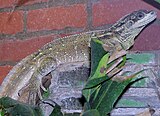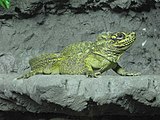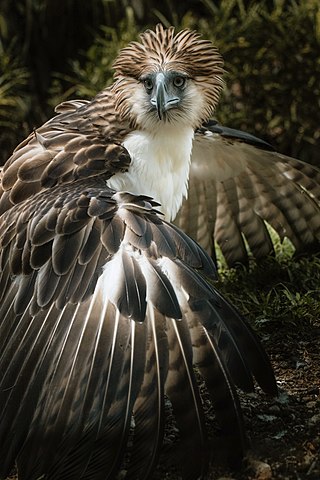
The Philippine eagle, also known as the monkey-eating eagle or great Philippine eagle, is a critically endangered species of eagle of the family Accipitridae which is endemic to forests in the Philippines. It has brown and white-colored plumage, a shaggy crest, and generally measures 86 to 102 cm in length and weighs 4.04 to 8.0 kg.

The plumed basilisk, also called the green basilisk, double crested basilisk, or Jesus Christ lizard, is a species of lizard in the family Corytophanidae. The species is native to Central America.

Hydrosaurus, commonly known as the sailfin dragons or sailfin lizards, is a genus in the family Agamidae. These relatively large lizards are named after the sail-like structure on their tails. They are native to Indonesia and the Philippines where they are generally found near water, such as rivers and mangrove. Sailfin lizards are semiaquatic and able to run short distances across water using both their feet and tail for support, similar to the basilisks. They are threatened by both habitat loss and overcollection for the wild animal trade.

Monitor lizards are lizards in the genus Varanus, the only extant genus in the family Varanidae. They are native to Africa, Asia, and Oceania, and one species is also found in the Americas as an invasive species. About 80 species are recognized.
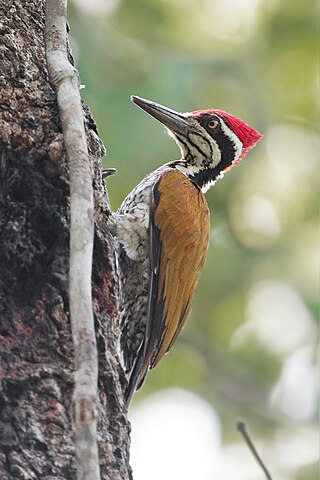
The greater flameback, also known as the greater goldenback or large golden-backed woodpecker, is a woodpecker species. It occurs widely in the northern Indian subcontinent, eastwards to southern China, the Malay Peninsula, Sumatra, western and central Java and northeast Borneo.

Physignathus cocincinus is a species of agamid lizard native to southern China and mainland Southeast Asia. It is commonly known as the Chinese water dragon, Indochinese water dragon, Asian water dragon, Thai water dragon, or green water dragon.
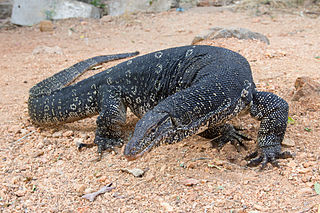
The Asian water monitor is a large varanid lizard native to South and Southeast Asia. It is one of the most common monitor lizards in Asia, ranging from coastal northeast India, Bangladesh, Sri Lanka, mainland Southeast Asia, and southern China to Indonesian islands where it lives close to water. It is listed as Least Concern on the IUCN Red List. It was described by Laurenti in 1768 and is among the largest squamates in the world.

The mangrove monitor, mangrove goanna, or Western Pacific monitor lizard is a member of the monitor lizard family with a large distribution from northern Australia and New Guinea to the Moluccas and Solomon Islands. It grows to lengths of 3.5 to 4 ft. It is also known as wbl yb in the Kalam language of Papua New Guinea.

Varanus timorensis, the Timor monitor or spotted tree monitor, is a species of small monitor lizards native to the island of Timor and some adjacent islands.
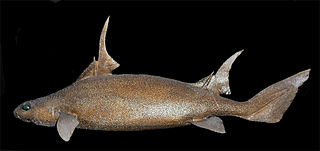
The sailfin roughshark is a species of dogfish shark in the family Oxynotidae, found in the eastern North Atlantic from Scotland to Senegal between latitudes 61°N and 11°N, at depths of between 265 and 720 m. Its length is up to 1.2 m (3.9 ft).

The rhinoceros iguana is an endangered species of iguana that is endemic to the Caribbean island of Hispaniola and its surrounding islands. A large lizard, they vary in length from 60 to 136 centimetres, and skin colours range from a steely grey to a dark green and even brown. Their name derives from the bony-plated pseudo-horn or outgrowth which resembles the horn of a rhinoceros on the iguana's snout. It is known to coexist with the Ricord's iguana ; the two species are the only taxa of rock iguana to do so.

The Philippine mouse-deer, also known as the Balabac chevrotain or pilandok, is a small, nocturnal ruminant, which is endemic to Balabac and nearby smaller islands southwest of Palawan in the Philippines. The genus Tragulus means 'little goat' and the Philippine mouse-deer has been named so due to the horizontal pupils of the eyes. This position of the pupil allows for an increase in peripheral depth perception. It has traditionally been considered a subspecies of the greater mouse-deer. In 2004, though, T. nigricans was separated from T. napu as its own species due to differences in skull morphology. Contrary to its common name, the Philippine mouse-deer does not belong to the true deer family (Cervidae), but is rather more closely connected to antelope and antelope-like bovids; it is a member of the chevrotain family, a grouping of some of the world's smallest hoofed mammals.
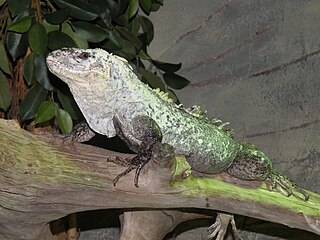
Ctenosaura bakeri, also known as the Utila spiny-tailed iguana, Baker's spinytail iguana, swamper or wishiwilly del suampo, is a critically endangered species of spinytail iguana endemic to the island of Utila, one of the Islas de la Bahía off the coast of Honduras in the Caribbean.

The Moluccan sail-finned lizard or Ambon sailfin dragon is a large agamid lizard native to moluccas or Maluku Islands in Indonesia, growing to about one metre (3.3 ft) in length. It is often confused for being the largest of the sailfin dragons; however, that title belongs to Hydrosaurus microlophus, with the second largest of the sailfin dragons being Hydrosaurus celebensis.

The Gray's monitor is a large monitor lizard known only from lowland dipterocarp forest in southern Luzon, Catanduanes, and Polillo Island, all islands in the Philippines. It is also known as Gray's monitor lizard, butaan, and ornate monitor. It belongs to the subgenus Philippinosaurus. It is largely arboreal and extremely shy. The population of northern Luzon was formerly included in the Gray's monitor, but has been recognized as a separate species, the northern Sierra Madre forest monitor, since 2010.

The northern caiman lizard is a species of lizard found in northern South America.

The yellow-headed water monitor, also commonly known as Cuming's water monitor, the Mindanao water monitor, and the Philippine water monitor, is a large species of monitor lizard in the family Varanidae. The species is endemic to the Philippines. It thrives in mangrove, forest and water margins in tropical refuges, where it feeds on birds, fishes, mammals, and carrion.

The Northern Sierra Madre forest monitor, also known by the local names bitatawa, baritatawa, and butikaw, is a large, arboreal, frugivorous lizard of the genus Varanus. The lizard is a distinctive food of the Aeta and Ilongot indigenous people of the Philippines.

Weber's sailfin lizard or Halmahera sailfin dragon, is a species of lizard in the family Agamidae. The species is endemic to Indonesia.

The Sulawesi black sailfin lizard is a species of agamid native to Indonesia. It is the second largest species of sailfin dragon, with only the Sulawesi giant sailfin dragon being larger., exceeding 1000 mm in total length, possibly 1200 mm. Head, neck, gular region and shoulder completely black; a row of enlarged flat, sometimes conical scales on either side of the neck; nuchal and dorsal crests continuous; a group of dirty white enlarged flat scales on the anterior part of the dorsum; few (<10) additional enlarged scales approximately at midbody and before the hindlimbs. Dorsal colouration is typically yellowish, sometimes dark orange, interspersed with black spots; ventrally beige, limbs black with a few yellow spots; scales under fourth and fifth toes are broad with several keels from near the base of the toe; tail black, sail black or dark violet with black stripes.


